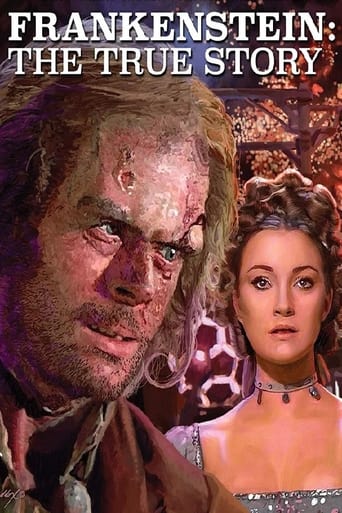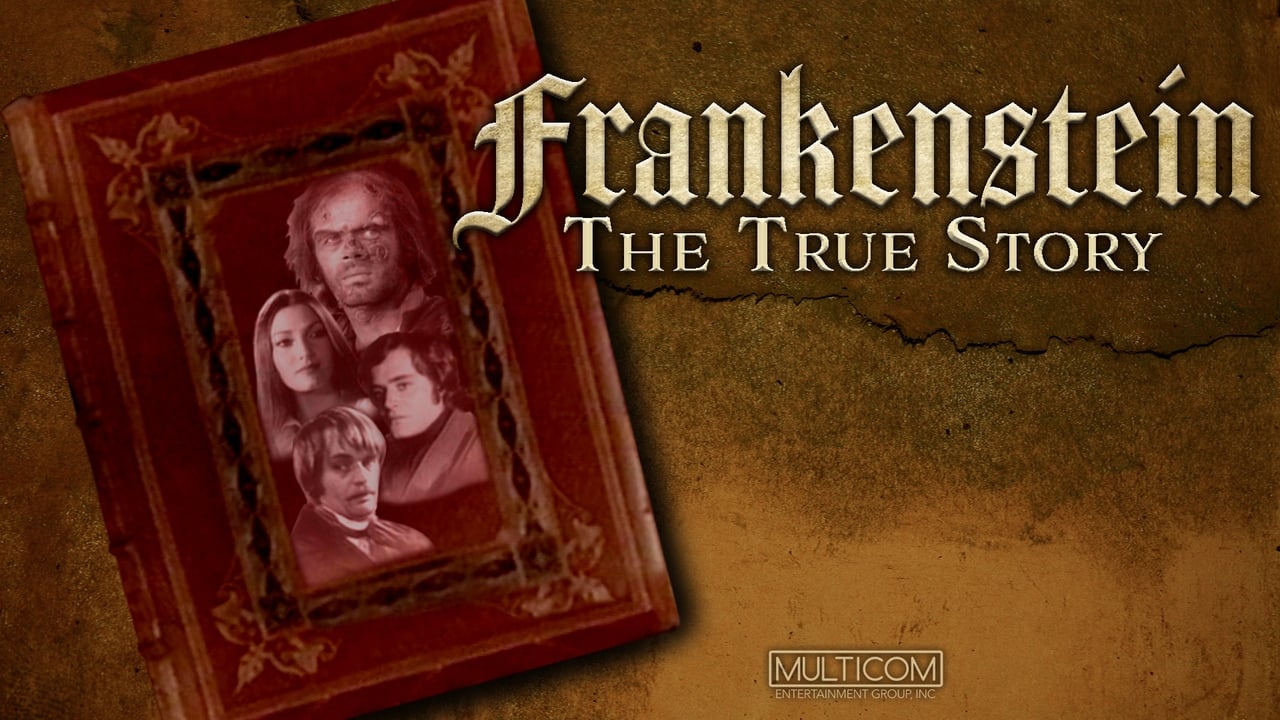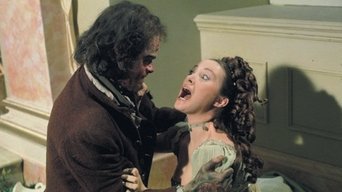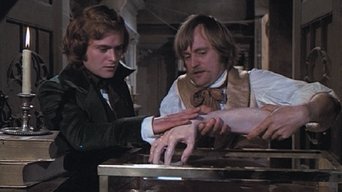bkoganbing
The indelible image of Frankenstein's monster was created by Boris Karloff in the
classic Frankenstein film from Universal in the early talkie days. That square head, those bolts protruding from the neck and that inarticulate rage set the
standard for the creature in dozens of films thereafter.In Frankenstein: The True Story we get a different slant on the creation. Dr. Victor Frankenstein is taken on as a protege by Dr. David McCallum who is experimenting with the origin of life and reviving the dead. McCallum is killed
but Whiting takes the experiment over and with some of the same bizarre
electronics via a lightning storm brings his creature to life and he looks a whole
lot like Michael Sarrazin.Sarrazin is certainly a kind of Frankenstein monster that we hadn't seen before.
But he's a failed experiment and he begins to deteriorate as dead bodies are
prone to do.The film follows the basic plot of both the original Frankenstein and the Bride
Of Frankenstein with Jane Seymour a girl killed in an accident brought back to
life by another scientist James Mason who has the best role in the piece. He's
a mad scientist, but he's one with real ambitions for Seymour. Let's say it
ain't love a first sight for Sarrazin and Seymour. You have to see what happens to Seymour at a society ball.Both acting knights Ralph Richardson as the blind fiddler and John Gielgud as
a constable are in this as well. This is also Michael Wilding's farewell film as
the father of Nicola Paggett who is Whiting's fiance.The kind of talent in the cast of this film makes it a winner. This one is different and if you are a fan of James Mason you should not miss this.
Parks
"Frankenstein - The True Story" starts with the redoubtable James Mason introducing himself and explaining that what we are about to see is all from the imagination of 19 year old Mary Shelley. It really isn't, you know. This film is a hybrid of the novel, the 1930's movies and the 1950's Hammer version, all mixed up by Christopher Isherwood of "Cabaret" and "A Single Man". The result is a sumptuous Gothic tragedy with a literate script.In this version, Dr. Frankenstein brings a corpse back to life using power from the sun. This is no lumbering monstrosity but a good- looking young chap, eager to learn and with a love of opera. So Victor and his creation get along very well - Victor teaches the creature refined etiquette and takes him out and about. But then Victor realises his monster is degenerating as time passes, and turning back into a walking corpse. As the creature's once-fine features crumble, Victor turns his back on the monster who responds first with confusion and grief, then fury. What I really liked about this version is that it makes the motives of all the key players fall into place. You really sympathise with this creature, rejected by an indifferent creator as a failed experiment. And while the film is not particularly gory or scary, there are some genuinely unsettling moments - like the insinuation that the monster's soul is an amalgam of all the dead that went into making him.There's a terrific cast including James Mason as the malevolent Dr. Polidori (and no-one seems quite so delighted with themselves when being evil as good old JM). Michael Sarrazin as the creature, David McCallum as Victor's mentor and Jane Seymour Medicine Woman as Yokel With Cleavage. Lots of other familiar faces turn up too including John Gielgud, Ralph Richardson, Tom Baker, Agnes "Endora" Morehead and even Yootha "Mildred" Joyce. I've never been a Frankenfan before, but I really enjoyed this one.
gftbiloxi
Every film version of FRANKENSTEIN has taken tremendous liberties with Mary Shelly's celebrated 1818 novel, and although it retains the core idea of the book this one is no exception. Produced for television by Universal Studios in 1973, the film contains a host of characters and ideas that draw more from previous film versions than from the original novel. More interestingly, however, it introduces a number of distinctly original concepts as well.Simply stated, the film has a highly disconcerting and surprisingly overt homo-erotic edge. Instead of the inevitable "mad doctor" typical of films, Victor Frankestein is a remarkably handsome young man in the form of actor Leonard Whiting, a performer best known as Romeo in the famous 1968 ROMEO AND JULIET. He is seduced into the experiment by the equally handsome but distinctly odd Henry Clerval (David McCallum)--and not only do the two actors play the relationship in a disquietingly touchy-feely way, Clerval takes exception to Victor's fiancée Elizabeth (Nicola Pagett) and she returns the favor, demanding that Victor choose between them.Lest any one miss the implications, the creature is played by none other than Michael Sarrazin, and while many men may be described as handsome, Sarrazin is among the few who can be justly described as beautiful. He arises from the laboratory table barely decent in a few strategically placed bandages, and when his facial covering is pulled aside by the eager Dr. Frankenstein we are treated to a lingering image of glossy black hair, pale complexion, remarkably liquid eyes, and lips that would make Vogue model weep with envy. Dr. Frankenstein takes him to his own apartment, where he educates this child-like innocent and very generously allows the creature to sleep in his own bed.But, as in all FRANKENSTEIN movies, the experiment goes awry, and when it does the same disconcerting homo-erotic overtones take yet another turn. Due to some unknown error in the creation process, the creature begins to deteriorate in appearance--and instead of continuing to treat him kindly, Frankenstein keeps the creature locked up, becomes verbally abusive to him, and no longer allows the creature to sleep in his bed, relegating him to a cramped mattress on the floor. At the same time, Frankenstein is approached by the mysterious Dr. Polidori (the legendary James Mason), an oily scientist with a flair for hypnosis who claims to know what went wrong.Polidori insists that they abandon the creature and create a new one: a woman, and when this new creation emerges from an entirely different process she too is remarkably beautiful; indeed, she is none other than Jane Seymour. But whereas the original creature was a gentle creature who only learned violence from Frankenstein's hateful rejection, this new entity is strangely icy, almost snake-like from the very beginning--and the male creature, now both vicious and wildly jealous, will exact a horrific toll upon all concerned.It is worth pointing out that the script for this version of FRANKENSTEIN was co-authored by Christopher Isherwood (1904-1986), one of the few openly gay writers of his era. Sexuality in general and homosexuality in particular forms a theme in many of Isherwood's works, so it would seem reasonable to assume that he was responsible for the homo-erotic elements of the film. Jack Smight's direction does not offer anything nearly so interesting as the script, but it is workman-like, and while the production values tend to be a shade too baroque for their own good one never lacks for something to look at on the screen.The cast is also quite good. At the time, the film was looked upon as a "television event," and it drew a host of noted actors, including John Gielgud and Agnes Moorehead. No one would accuse Leonard Whiting of being a great screen talent, but he acquits himself very well; so too does David McCallum, Nicola Pagett, and the always memorable James Mason. But the real knock-out performances here are by Sarrazin and Seymour, who truly blow the lid off our ideas of what a FRANKENSTEIN movie should be--and when they square off the result is unsettling in a truly unexpected way. In terms of the DVD itself, the film quality is considerably better than the rare late-night showings I've occasionally seen on television, but I would not describe it as pristine, and I found I frequently had to bump up the volume on the soundtrack.If you are looking for something with which to scare yourself silly, you might want to give this version FRANKENSTEIN a miss; although it has a few visceral moments, the jolts involved are largely psycho-sexual. But if you are open to the sexually subversive, which is particularly unexpected in a made-for-television film from 1973, you couldn't make a better choice. Recommended.GFT, Amazon Reviewer
MARIO GAUCI
I had always wanted to watch this after reading about it in Alan Frank's book "Horror Films", but missed out on it on Italian TV as a kid. When it was announced for DVD release, I pre-ordered it (despite being a bare-bones affair) but, after reading the first negative review - via DVD Talk, as there was mention of poor video quality and even edited footage - I almost cancelled it outright! However, having watched it myself, I found no complaints with the former and, being a first viewing, I had no opinion about the latter - to be honest, Frank's description of The Creature ripping out Prima's head from her body had fired up my imagination all these many years, and found the scene as is in the film something of a let-down, but I couldn't verily say if it was trimmed or not; likewise, I felt that the opening sequence (the drowning of Frankenstein's younger brother) was too abrupt, i.e. without having taken the time to create a genuine rapport between the two (which would have made Victor's subsequent obsession with bringing the dead back to life that much more purposeful!)...but, again, I don't know if it has always been this way or if it originally ran longer!! The prologue was a mistake, in my opinion, as it feels awkward - like a Theatrical Trailer attached to the beginning of a movie, complete with spoilers galore! Obviously, I've watched countless adaptations of the Mary Shelley classic along the years - and it's always interesting to see the way in which the original text is 're-invented' by the various writers and film-makers; this epic, star-studded production is certainly among the most intelligent, literate renditions (co-scripted by Christopher Isherwood) although, to be honest, I found it most compelling during the first hour or so; maybe that's because I was used to seeing a hulking, misunderstood creature rather than the dapper and relatively inconspicuous one depicted here! Besides, David MacCallum's contribution is so strong (I had seen him in a few films and TV shows, but nothing as impressive as this!) during these initial stages that when his character is killed off, immediately prior to the first creation scene, it never fully recovers!! Still, James Mason's Dr. Polidori makes for a great villain in the Praetorius tradition (though nothing so campy as Ernest Thesiger); in fact, even if the character is somewhat overwritten (coming off as a power-mad evil genius more akin to Fu Manchu than anything else, flanked by a couple of Asian henchmen no less!), Mason's playing is generally understated throughout - yet effortlessly dominating every scene he's in. Leonard Whiting isn't bad as Frankenstein, simply too youthful for the role - displaying none of the intensity of Colin Clive or the fastidiousness of Peter Cushing. Michael Sarrazin, as I said before, makes for a rather unalarming creature - though his subsequent physical and mental deterioration provides some undeniably effective moments (such as in the afore-mentioned scene with Prima, the unsuccessful attempt by Polidori and Frankenstein to destroy him, and the doomed sea voyage at the finale); that said, it appears that the conception itself of The Creature has problems: at first, MacCallum's Henry Clerval complains that he has been saddled with a peasant's brain for his creation and, yet when Frankenstein eventually substitutes it with that of Clerval himself, Sarrazin still emerges an illiterate - until the very end when he unaccountably starts reasoning the way Clerval would have and is even able to guide the ship to the Arctic (it somehow doesn't feel right that Prima receives schooling whereas The Creature does not, or rather learns precious little from his various misadventures, such as the encounter with the blind hermit or his sojourn with Polidori - when both these incidents, as depicted in BRIDE OF FRANKENSTEIN [1935], had proved crucial to The Creature's formation of character)! One of the most satisfying aspects to the film is the unusually strong participation of the female leads, both of whom add effortless grace to the proceedings but also deliver fine performances: Nicola Pagett is certainly the most significant Elizabeth I have seen, while Jane Seymour appears in a 'dual' role as the blind hermit's grand-daughter and the mischievous, sexy Prima (The Creature's female counterpart whom Dr. Polidori proposes to integrate into affluent London society, for his own sinister ends, with disastrous consequences). The supporting cast is chosen with an eye to adding further distinction to the production if little else, as none of the various thespians are particularly taxed by the brief roles they have been offered! The film was made by Universal, interestingly enough, but shooting took place in London (to where the story itself is, bafflingly, re-set for the most part!). Even if director Smight didn't usually dabble in the horror genre, he managed the task competently enough - though the end result is essentially uninspired, and too genteel in the long run; nevertheless, he's aided immeasurably in the visual stakes by the sterling contribution of cinematographer Arthur Ibbetson and production designer Wilfred Shingleton.


 AD
AD




